Plates And Bowls Are Called


Tableware is any dish or dishware used for setting a table, serving food, and dining. Information technology includes cutlery, glassware, serving dishes, and other items for practical as well as decorative purposes.[ane] [two] The quality, nature, variety and number of objects varies according to civilisation, religion, number of diners, cuisine and occasion. For case, Centre Eastern, Indian or Polynesian food culture and cuisine sometimes limits tableware to serving dishes, using bread or leaves as individual plates. Special occasions are usually reflected in higher quality tableware.[three]
Cutlery is more usually known as silverware or flatware in the United states, where cutlery usually means knives and related cutting instruments; elsewhere cutlery includes all the forks, spoons and other silverware items. Outside the United states of america, flatware is a term for "open-shaped" dishware items such as plates, dishes and bowls (equally opposed to "closed" shapes like jugs and vases). Dinnerware is some other term used to refer to tableware and crockery refers to ceramic tableware, today often porcelain or bone communist china.[4] Sets of dishes are referred to equally a table service, dinner service or service ready. Table settings or identify settings are the dishes, cutlery and glassware used for formal and informal dining. In Ireland, such items are normally referred to as delph, the word being an English language language phonetic spelling of the give-and-take Delft, the boondocks from which so much delftware came. Argent service or butler service are methods for a butler or waiter to serve a repast.
Setting the table refers to arranging the tableware, including individual identify settings for each diner at the table also every bit decorating the table itself in a fashion suitable for the occasion. Tableware and table ornament is typically more elaborate for special occasions. Unusual dining locations need tableware exist adapted.
Materials [edit]

In recent centuries, flatware is usually made of pottery, ceramic materials such as earthenware, stoneware, os china or porcelain. The triumph of ceramics is probably due to the spread of ceramic glazes, which were slow to develop in Europe; without the glassy surface they give, pottery tableware may be less hygienic. Table ware tin can be fabricated of other materials such as wood, pewter, latten, silver, gilt, glass, acrylic and plastic. Before it was possible to purchase mass-produced tableware, it was fashioned from available materials, such as wood. Industrialisation and developments in ceramic manufacture fabricated inexpensive washable tableware available. It is sold either by the piece or equally a matched set for a number of diners, normally four, 6, eight, or twelve place settings. Big quantities are purchased for employ in restaurants. Individual pieces, such as those needed every bit replacement pieces for broken dishes, tin can exist procured from "open stock" inventory at shops, or from antique dealers if the pattern is no longer in production.
Cutlery is normally fabricated of metal of some kind, though large pieces such equally ladles for serving may be of forest.
History [edit]
Plates and other vessels [edit]
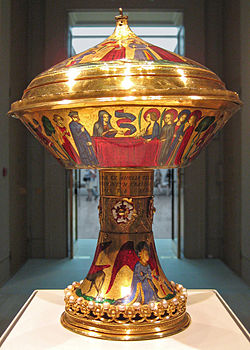
The Royal Aureate Cup, 23.vi cm high, 17.eight cm beyond; weight ane.935 kg, British Museum. Saint Agnes appears to her friends in a vision. Before 1391, when it was endemic by the Male monarch of France. Ane of a handful of medieval survivals, solid gold with enamels.
The primeval pottery in cultures effectually the globe does not seem to have included flatware, concentrating on pots and jars for storage and cooking. Wood does not survive well in near places, and though archaeology has constitute few wooden plates and dishes from prehistory, they may have been common, once the tools to fashion them were available.
Ancient elites in most cultures preferred flatware in precious metals ("plate") at the table; Red china and Japan were two major exceptions, using lacquerware and afterwards fine pottery, especially porcelain. In China bowls accept ever been preferred to plates. In Europe pewter was oftentimes used past the less well off, and eventually the poor, and silver or gold by the rich. Religious considerations influenced the choice of materials. Muhammad spoke against using gold at table, as the gimmicky elites of Persia and the Byzantine Empire did, and this profoundly encouraged the growth of Islamic pottery. On the other hand, Hindus avoided eating off pottery[ why? ].
In Europe the elites dined off metal, commonly silver for the rich and pewter for the middling classes, from the ancient Greeks and Romans until the 18th century. The trencher was a big apartment piece of either bread or woods. In the Eye Ages this was a common way of serving food, the breadstuff too being eaten; even in elite dining it was non fully replaced in France until the 1650s,[five] although in Italian republic maiolica was used from the 15th century. Orders survive for large services. At an Este family wedding ceremony feast in Ferrara in 1565, 12,000 plates painted with the Este arms were used, though the "superlative table" probably eat off precious metal.[6]
Possession of tableware has to a large extent been determined past private wealth; the greater the means, the higher was the quality of tableware that was owned and the more than numerous its pieces. The materials used were often controlled by sumptuary laws. In the late Center Ages and for much of the Early Mod period much of a nifty person's dispensable assets were often in "plate", vessels and tableware in precious metal, and what was not in utilize for a given meal was ofttimes displayed on a dressoir de parement or buffet (similar to a large Welsh dresser) against the wall in the dining hall. At the hymeneals of Philip the Good, Duke of Burgundy, and Isabella of Portugal in 1429, there was a dresser xx feet long on either side of the room, each with five rows of plate;[seven] a similar display on three dressoirs could be seen at the State Feast in Buckingham Palace for President Donald J. Trump in 2019. Inventories of King Charles 5 of French republic (r. 1364–1380) record that he had 2,500 pieces of plate.[eight]
Plate was oftentimes melted down to finance wars or building, or until the 19th century only for remaking in a more stylish style, and hardly whatsoever of the enormous quantities recorded in the later Centre Ages survives.[ix] The French Royal Gold Cup at present in the British Museum, in solid gold and decorated with enamel and pearls, is one of few secular exceptions. Weighing more than than two kilos, it was mayhap passed around for formalism toasts.[9] Some other is the much plainer English silverish Lacock Loving cup, which has survived as it was bequeathed to a church early on, for use as a chalice.
The same is true for French silvery from the 150 years before the French Revolution, when French styles, either originals or local copies, were used by all the courts of Europe. London silversmiths came a long mode backside, just were the other main exporters. French silver now survives well-nigh entirely in the form of exported pieces, like the Germain Service for the King of Portugal.[10]

In London in the 13th century, the more affluent citizens owned fine furniture and silvery, "while those of straiter means possessed only the simplest pottery and kitchen utensils." By the subsequently 16th century, "fifty-fifty the poorer citizens dined off pewter rather than wood" and had plate, jars and pots fabricated from "green glazed earthenware".[11] The dignity often used their arms on heraldic china.
The concluding replacement of silver tableware with porcelain as the norm in French aristocratic dining had taken place past the 1770s.[12] Later on this the enormous development of European porcelain and cheaper fine earthenwares similar faience and creamware, as well as the resumption of large imports of Chinese consign porcelain, oftentimes armorial porcelain busy to lodge, led to matching "china" services condign affordable by an ever-wider public. By 1800 cheap versions of these were oftentimes brightly decorated with transfer printing in blue, and were start to exist affordable past the amend-off working-course household. Until the mid-19th century the American market was largely served by imports from Uk, with some from Communist china and the European continent.
The introduction of hot drinks, by and large but not only tea and coffee, every bit a regular characteristic of eating and entertaining, led to a new class of tableware. In its most common material, various types of pottery, this is often chosen teaware. It developed in the late 17th century, and for some time the serving pots, milk jugs and sugar bowls were often in silver, while the cups and saucers were ceramic, often in Chinese consign porcelain or its Japanese equivalent.[xiii] By the mid 18th century matching sets of European "communist china" were usual for all the vessels, although these often did not include plates for cake etc. until the adjacent century. This move to local mainland china was rather delayed past the tendency of some early on types of European soft-paste porcelain to break if also hot liquid was poured into information technology.
Cutlery [edit]
The knife is much the oldest type of cutlery; early ones were unremarkably carried by the individual at all times. Forks and spoons came later on, and are initially merely for the wealthy, who typically carried their own personal fix. Later the Romans, who made slap-up use of spoons, joined by forks afterwards,[14] in that location were only knives and maybe wooden spoons for most of the Center Ages. It was just in the 17th century that hosts among the elite again began to lay out cutlery at the tabular array,[v] although at an Italian feast in 1536 for Charles V, Holy Roman Emperor, it is recorded that each guest was provided with pocketknife, spoon and fork, evidently a rarity.[15] The table fork was revived in Italy in the 16th century, and was described for his English readers by Thomas Coryat in the 1590s as "non used in whatever other state that I saw in my travels".[16] In England and France, information technology only became common after the 1660s, even in the court of Louis 14,[17] and for a while seems to accept more often than not been used by ladies, and for peculiarly messy food, like fruits in syrup.[18]
Table decoration [edit]
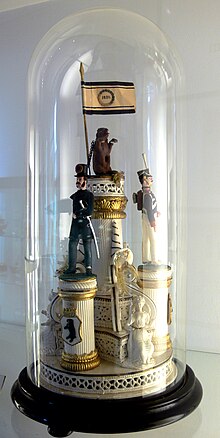
Tableware is generally the functional part of the settings on dining tables but peachy attention has been paid to the purely decorative aspects, especially when dining is regarded as part of entertainment such equally in banquets given past of import people or special events, such every bit State occasions.[19] Table decoration may be imperceptible and consist of items made from confectionery or wax - substances commonly employed in Roman banqueting tables of the 17th century. During the reign of George Iii of the United kingdom of great britain and northern ireland, imperceptible table decoration was done by men known every bit "tabular array-deckers" who used sand and similar substances to create marmotinto works (sand painting) for unmarried-use ornamentation.[19] In modern times, ephemeral table decorations keep to exist made from carbohydrate or carved from ice.
The porcelain figurine began in early 18th-century Federal republic of germany equally a permanent replacement for carbohydrate sculptures on the dining table.
In wealthy countries such equally 17th century France, table decorations for the aristocracy were sometimes made of silver. I of the virtually famous table decorations is the Cellini Salt Cellar. Ephemeral and silver table decorations were replaced with porcelain items after its reinvention in Europe in the 16th century.
Western style [edit]

Setting the table for a family meal, Leipzig (1952)
Table settings [edit]
A table setting in Western countries is mainly in 1 of 2 styles: service à la russe (French for "in the Russian way"), where each course of the meal is brought out in specific guild; and service à la française (French for "in the French mode"), where all the courses for the meal are bundled on the tabular array and presented at the same fourth dimension that guests are seated. Service à la russe has become the custom in most restaurants, whereas service à la française is the norm in family settings.
Identify settings for service à la russe dining are arranged according to the number of courses in the meal. The tableware is arranged in a particular guild. With the first class, each guest at the table begins past using the tableware placed on the exterior of place setting. As each grade is finished the guest leaves the used cutlery on the used plate or bowl, which are removed from the table by the server. In some case, the original set is kept for the next course. To begin the adjacent course, the diner uses the next detail on the exterior of the place setting, and so on. Forks are placed on the left of a dinner plate, knives to the right of the plate, and spoons to the outer right side of the place setting.
Plates and bowls [edit]

Service à la russe formal place setting showing glassware for a range of beverages

Table laid out for a banquet in Toulouse at the Palais Niel (2010)
Plates Dinner plate with rolled table napkin; small bread plate above forks.
Glasses Small glass for water, larger ane backside for cerise wine, and smaller vino glass for white wine.
Cutlery (from the outside toward the plate) Fish cutlery (knife and fork, as fish will be served without whatsoever sauce, otherwise it would be a fish spoon (cuillère à gourmet)); meat cutlery and cheese or fruit cutlery, the end of the knife rests on a pocketknife rest. In a higher place the plate, dessert cutlery (spoon and fork).
Items of tableware include a variety of plates, bowls; or cups for individual diners and a range of serving dishes to transport the food from the kitchen or to divide smaller dishes. Plates include charger plates every bit well as specific dinner plates, lunch plates, dessert plates, salad plates or side plates. Bowls include those used for soup, cereal, pasta, fruit or dessert. A range of saucers accompany plates and bowls, those designed to get with teacups, coffee cups, demitasses and cream soup bowls. There are as well individual covered casserole dishes.
Dishes come up in standard sizes, which are set according to the manufacturer. They are similar throughout the industry. Plates are standardised in descending lodge of diameter size according to role. One standard series is charger (12 inches); dinner plate (10.v inches); dessert plate (8.5 inches) salad plate (7.5 inches); side plate, tea plate (six.75 inches).
Drinkware [edit]
Glasses and mugs of various types are an of import part of tableware, as beverages are important parts of a meal. Vessels to agree alcoholic beverages such as wine, whether ruby-red, white, sparkling tend to be quite specialised in form, with for instance Port vino glasses, beer glasses, brandy balloons, aperitif and liqueur glasses all having different shapes. Water glasses, juice glasses and hot chocolate mugs are also differentiated. Their appearance as part of the tableware depends on the meal and the style of table system.
Tea and coffee tend to involve stiff social rituals and so teacups and, coffee cups (including demitasse cups) have a shape that depends on the culture and the social situation in which the drinkable is taken.
Cutlery [edit]
Cutlery is an important office of tableware. A basic formal place setting will normally have a dinner plate at the centre, resting on a charger. The residual of the place setting depends upon the offset course, which may be soup, salad or fish.[20]
- If soup is the first course, to the left of the dinner plate, moving clockwise, are placed a small salad fork to the left of the dinner plate; a big dinner fork to the left of the salad fork; a side plate above the forks; a wine or water glass higher up and to the right of the dinner plate; a large dinner pocketknife to the right of the dinner plate; a smaller butter knife to the correct of the dinner pocketknife; a dinner spoon to the correct of the knives; a soup spoon to the right of the dinner spoon.
- If salad is the first form, the soup spoon is skipped. The dinner fork is placed immediately left of the dinner plate; the salad fork is placed on the outer left side of the identify setting.
In either arrangement, the napkin may either residue folded underneath the forks, or it may be folded and placed on the dinner plate.
When more courses are being served, place settings may become more elaborate and cutlery more than specialised. Examples include fruit spoon or fruit knife, cheese pocketknife, and pastry fork. Other types of cutlery, such every bit boning forks, were used when formal meals included dishes that have since get less common. Carving knives and forks are used to carve roasts at the table.
Serving dishes [edit]

Tableware for serving mint tea

A wide range of serving dishes are used to transport food from kitchen to table or to serve it at table, in social club to make food service easier and cleaner or more efficient and pleasant. Serving dishes include: butter dishes; casseroles; fruit bowls; ramekins or lidded serving bowls; compotes; pitchers or jugs; platters, salvers, and trays; salt and pepper shakers or salt cellars; sauce or gravy boats; tureens and tajines; vegetable or salad bowls.
A range of items specific to the serving of tea or coffee too have long cultural traditions. They include teapots and coffee pots as well as samovars, carbohydrate bowls; milk or cream jugs.
Identify markers [edit]
Place markers are used to designate assigned seats to guests. They are typically used at large formal functions such as weddings, banquets for dignitaries, politicians or diplomats as well as on special occasions such as large children's parties. Some are collectible[21]
Chinese style [edit]

A identify setting for a Chinese meal
Chinese tabular array settings are traditional in style. Table setting practices in Japan and other parts of Due east Asia accept been influenced by Chinese tabular array setting customs.[22] The emphasis in Chinese table settings is on displaying each individual food in a pleasing way, usually in split up bowls or dishes. Formal table settings are based upon the arrangements used in a family unit setting, although they can become extremely elaborate with many dishes. Serving bowls and dishes are brought to the tabular array, where guests tin choose their own portions. Formal Chinese restaurants often use a large turning wheel in the heart of the table to rotate food for easier service.
In a family setting, a repast typically includes a fan dish, which constitutes the meal's base of operations (much like staff of life forms the base of operations of diverse sandwiches), and several accompanying mains, called cai dish (choi or seoung in Cantonese). More specifically, fan normally refers to cooked rice, just tin can also be other staple grain-based foods. If the meal is a low-cal meal, it will typically include the base and i main dish. The base is frequently served directly to the invitee in a bowl, whereas main dishes are called past the guest from shared serving dishes on the table.[23]
- Identify setting
An "elaborate" formal meal would include the post-obit identify setting:[22]
- Center plate, about 6 inches in bore
- Rice bowl, placed to the correct of the center plate
- Minor cup of tea, placed to a higher place the plate or rice bowl
- Chopsticks to the right of the centre plate, on a chopstick rest
- A long-handled spoon on a spoon residuum, placed to the left of the chopsticks
- Small condiment dishes, placed above the centre plate
- Soup bowl, placed to the left above the centre plate
- A soup spoon, inside the soup bowl
Japanese mode [edit]
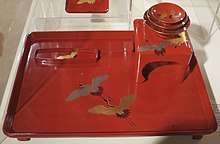
New year's day sake set up with images of cranes, lacquer on woods (Japan, late 19th century)

A Japanese table setting.
Japanese ceramic tableware is an industry that is many centuries old. Unlike in Western cultures, where tableware is frequently produced and bought in matching sets, Japanese tableware is set on the table so that each dish complements the type of food served in it. Since Japanese meals normally include several pocket-size amounts of each food per person, this means that each person has a place setting with several dissimilar small dishes and bowls for property private food and condiments. The emphasis in a Japanese tabular array setting is on enhancing the appearance of the food, which is partially accomplished by showing contrasts between the items. Each bowl and dish may have a different shape, colour or pattern.[24]
- Place setting
A basic complete place setting for 1 person in Nippon would include the following:[25]
- Hot noodle basin
- Rice bowl
- Soup basin
- Ii to 3 shallow three- to 5-inch diameter dishes
- Two to three iii- to 5-inch diameter, 1- to iii-inch-deep bowls
- Two foursquare or rectangular pieces, traditionally served for serving fish
- Three 2- to 3-inch diameter additive plates
- Zaru (Cold noodle tray with bamboo strainer)
- Dipping sauce cup
- Chopsticks and chopstick residual
Not all of these plates and bowls would be necessary for one meal. A rice basin, a soup bowl, two or three small dishes with accompanying foods, and two or three condiment dishes for person would be typical. Various serving bowls and platters would also be assail a tabular array for a typical meal, along with a soy sauce cruet, a small-scale pitcher for tempura or other sauce, and a tea setting of tea pot, tea cups and tea cup saucers.
Adaptations [edit]

Carefully packed tableware in a picnic set for 4 persons (1909)
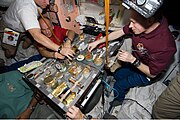
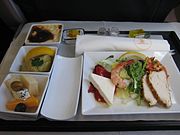
Business organisation-class airline meal with tightly bundled plates, unmarried-service condiments and serving tray.
Tableware for special circumstances has to be adapted. Dining in the outdoors, for example, whether for recreational purposes, as on a picnic or as part of a journey, projection or mission requires specialised tableware. It must exist portable, more robust and if possible, lighter in weight than tableware used indoors. Information technology is normally advisedly packed for transportation to the place where it will be used.
See also [edit]
- Armorial ware
- Category:Ceramics manufacturers
- Category:Types of pottery decoration
- Dishmaker
- Dishwashing
- Dishwashing auto
- Dishwashing soap
- Tupperware
Notes [edit]
- ^ Bloomfield, Linda (2013). Contemporary tableware. London: A. & C. Blackness. ISBN9781408153956.
- ^ Venable, Charles L.; et al. (2000). Cathay and Glass in America, 1880-1980: From Table Top to TV Tray. New York: Harry N. Abrams. ISBN0-8109-6692-1.
- ^ "Tableware". Encyclopædia Britannica.
- ^ Hughes, G. Bernard (George Bernard); Hughes, Therle (1955). English porcelain and bone red china. London: Lutterworth Press. ISBN0-7188-1392-viii. OCLC 220307242.
- ^ a b Strong, 226
- ^ Strong, 166-167; the hymeneals was betwixt Alfonso II d'Este, Duke of Ferrara and Barbara of Republic of austria
- ^ Potent, 96-98. Stiff says 1429, the year the proxy nuptials took place. The bride arrived by sea in tardily 1429, but the formal marriage ceremony was not until January 1430.
- ^ Strong, 97
- ^ a b Osborne, 733
- ^ Strong, 237
- ^ Peter Ackroyd (2003). London: the biography (1st Anchor Books ed.). New York: Anchor books. ISBN0385497717. p.55, 96
- ^ Strong, 232-233
- ^ Osborne, 736; Potent, 225-226
- ^ Strong, 33
- ^ Strong, 170
- ^ Strong, 167
- ^ Strong, 168 (France); Osborne, 736 (England)
- ^ Strong, 168-170
- ^ a b Barbarous, George (1970). Dictionary of Antiques ([2nd rep.] ed.). London: Barrie & Jenkins. pp. 419–420. ISBN0214652459.
- ^ Cunningham, Marion (1996). The Fannie Farmer Cookbook. Alfred A. Knopf, Inc. p. 817. ISBN0679450815.
- ^ "Place marker". Horniman Museum and Gardens.
- ^ a b Kotschevar, Lendal H. & Valentino Luciani (2006). Presenting Service: The Ultimate Guide for the Foodservice Professional . John Wiley & Sons. p. 119. ISBN9780471475781.
- ^ Newman, Jacqueline M. (2004). Nutrient Culture in China. Greenwood Publishing Group. p. 105. ISBN9780313325816.
- ^ Lowry, Dave (2010). The Connoisseur's Guide to Sushi: Everything You Need to Know about Sushi Varieties and Accompaniments, Etiquette and Dining Tips, and More. ReadHowYouWant.com. pp. 313–4. ISBN9781458764140.
- ^ Moriyama, Naomi (2006). Japanese Women Don't Get Old or Fat: Secrets of My Mother's Tokyo Kitchen. Random House Digital. pp. 74–5. ISBN9780385339988.
References [edit]
- Osborne, Harold (ed), The Oxford Companion to the Decorative Arts, 1975, OUP, ISBN 0198661134
- Strong, Roy, Feast: A History of Thousand Eating, 2002, Jonathan Greatcoat, ISBN 0224061380
Farther reading [edit]
- Von Drachenfels, Suzanne (2000). The Art of the Table: A Complete Guide to Table Setting, Table Manners, and Tableware. Simon & Schuster. ISBN 0-684-84732-9.
External links [edit]
-
 Media related to Tableware at Wikimedia Commons
Media related to Tableware at Wikimedia Commons - Jones, Edward Alfred (1911). . Encyclopædia Britannica. Vol. 21 (11th ed.). pp. 789–804.
Plates And Bowls Are Called,
Source: https://en.wikipedia.org/wiki/Tableware
Posted by: gillhamboyaceing.blogspot.com


0 Response to "Plates And Bowls Are Called"
Post a Comment